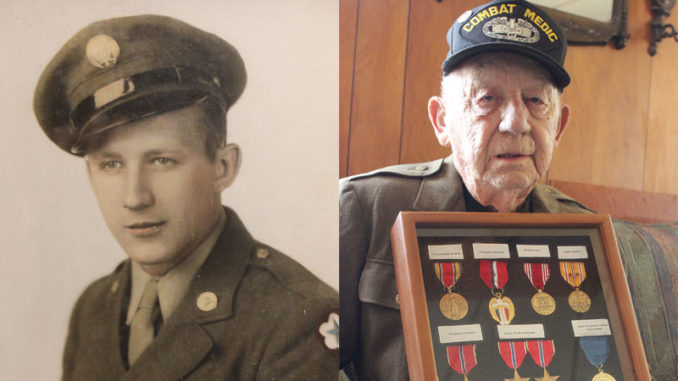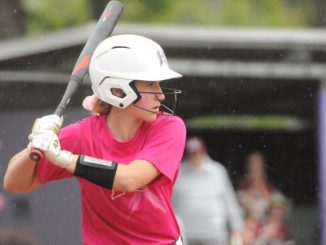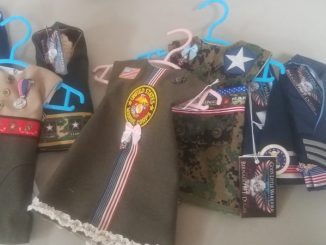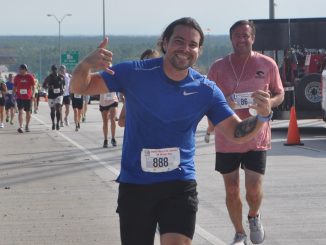
95-year-old was awarded 3 Bronze Stars for service
Comfortably slipping on his U.S. Army jacket and combat medic cap, Ted Davis recounted the many World War II battles he survived that earned him three Bronze Star medals.
“It was a battle every time we went out there,” the Norco resident said of his four years overseas.
At age 95, Davis himself is a historical treasure with an estimated 15 WWII veterans in St. Charles Parish and 620,000 nationally remaining of the 16 million Americans who served in this war.
They are in their late 80s and 90s as of this year, according to the U.S. Department of Veterans Affairs, and quickly passing away – taking history with them.
Less than a year after Japan attacked Pearl Harbor, Davis was on a vessel headed to the Pacific for the Philippines Campaign in 1942.
One of his points of destination was Port Moresby, the capital and largest city of Papua New Guinea, where he went on jungle marches. The city was home to an important Allied complex of bases and thousands of troops that pushed back the Japanese advances.
Davis served under Gen. Douglas MacArthur, the Supreme Commander of the Southwest Pacific Theater of Operations. MacArthur’s relentless march isolated all of the Japanese Army on New Guinea and the Admiralty Islands.
“We never saw him at all,” Davis said. “But he was good.”Because every invasion required a medic and a cook, Davis was among the people who went to so many battles that they were nicknamed “island hoppers.”
“It was battles every time we went to an island,” he said. “We just kept going up the island until we took the whole island.”
In November of 1942, Allied Defenses, armed with five gun carriers from Port Moresby, attacked Japanese-occupied Cape Endaiadere, which was located east of Strip Point near Buna village on Papua New Guinea.
Davis recalled the bloody battle, which left so many dead from both sides that the beach was nicknamed “Maggot Beach.”He also recalled how Japanese snipers were tied to coconut trees and they wouldn’t move so MacArthur had entire coconut groves cut down.
“When you cut the trees down, they just rotted up there,” Davis said.
MacArthur’s military forces pushed ahead in their relentless march to reclaim the Pacific islands, and Davis witnessed firsthand the war’s toll on human life as a medic.
“Every time we went into the jungle we’d bring the dog tags back of deceased soldiers,” he said. “The wounded, we treated the best we could.”
Davis said he gave them pain killers and antibiotics “to give them a chance to get back.”
As islands were reclaimed, the U.S. Army also discovered American prisoners of war, which Davis aided at the many temporary hospitals between invasions. Sometimes, he met people from Louisiana and found out they were from Baton Rouge and one soldier even knew his neighbor in Norco.
As the battles raged on, the medics were forced to deal with difficult conditions.
“It was 95 degrees in the morning and then 120 in the afternoon,” he said. “I didn’t see fresh meat for 18 months in the jungle – all canned stuff.”
Davis himself survived 10 cases of typhus and malaria, recounting the high fever and aching bones.
“It was no fun at all,” he said. “You lived with malaria half the time over there.”
By Jan. 5, 1946, Davis returned to the United States. He is widowed and lives alone, but his children help care for him.Davis survived the Philippines campaign that claimed thousands of U.S. Army and Air forces lives and wounded thousands more.
Many of them owe their survival to this medic.
The West St. Charles VFW Post 3750 will hold a Veteran’s Day ceremony to celebrate Davis and other war veterans at 11 a.m. Friday (Nov. 11) at the St. Charles Parish Courthouse
Hahnville High School’s ROTC also will hold a Veteran’s Day Memorial Service Friday (Nov. 11) at 10 a.m. at the Veteran’s Memorial in Des Allemands.




Be the first to comment